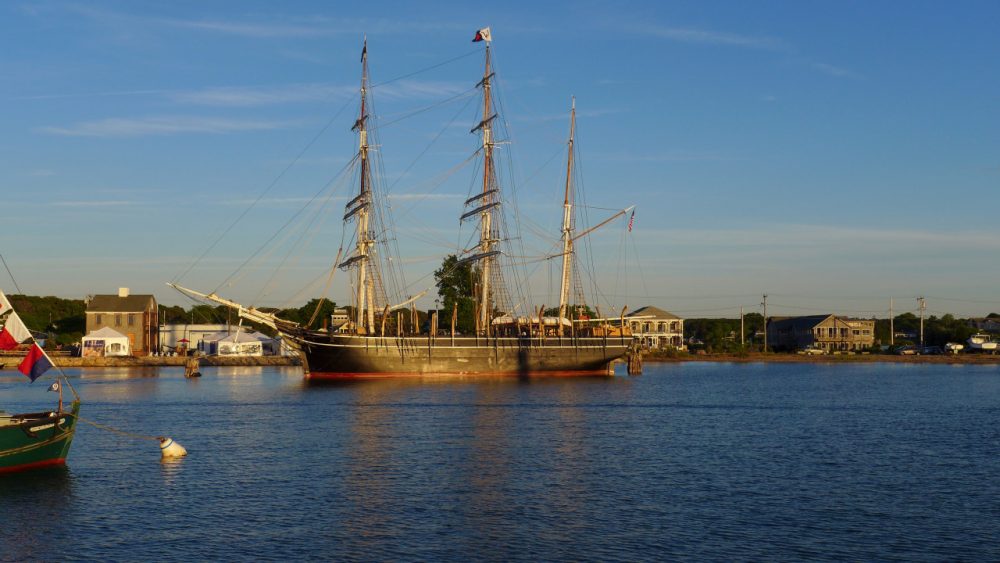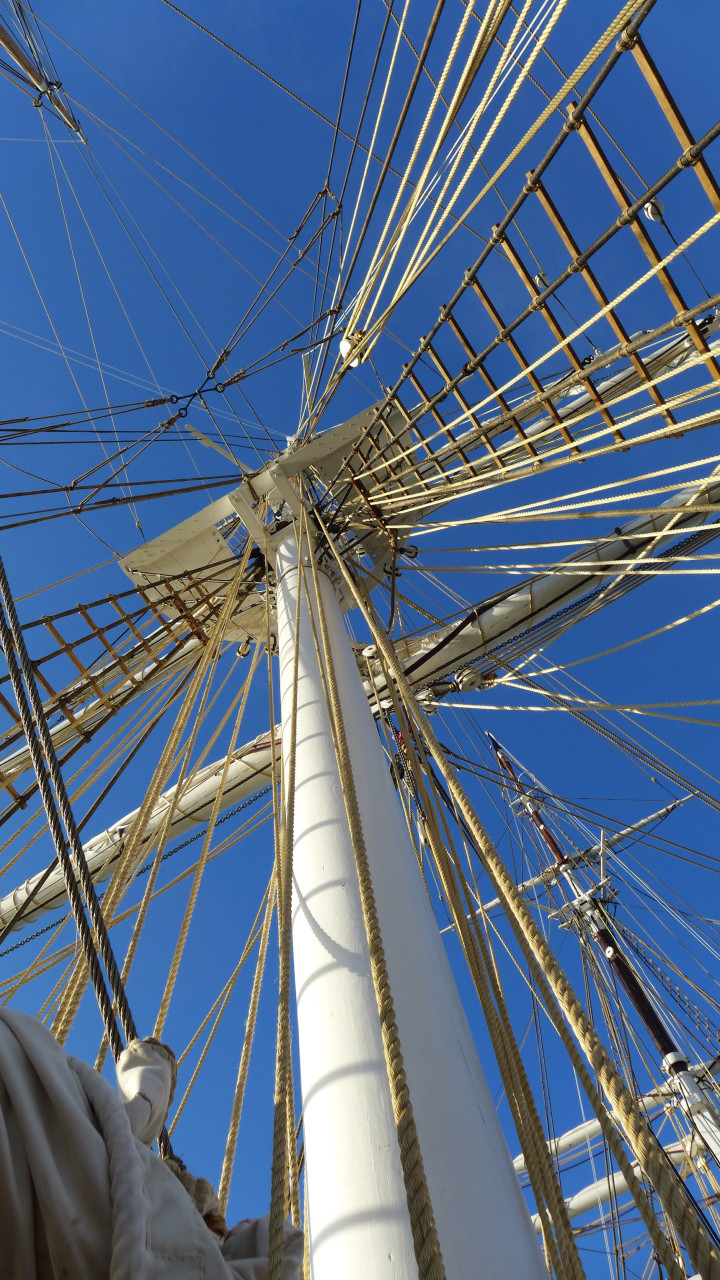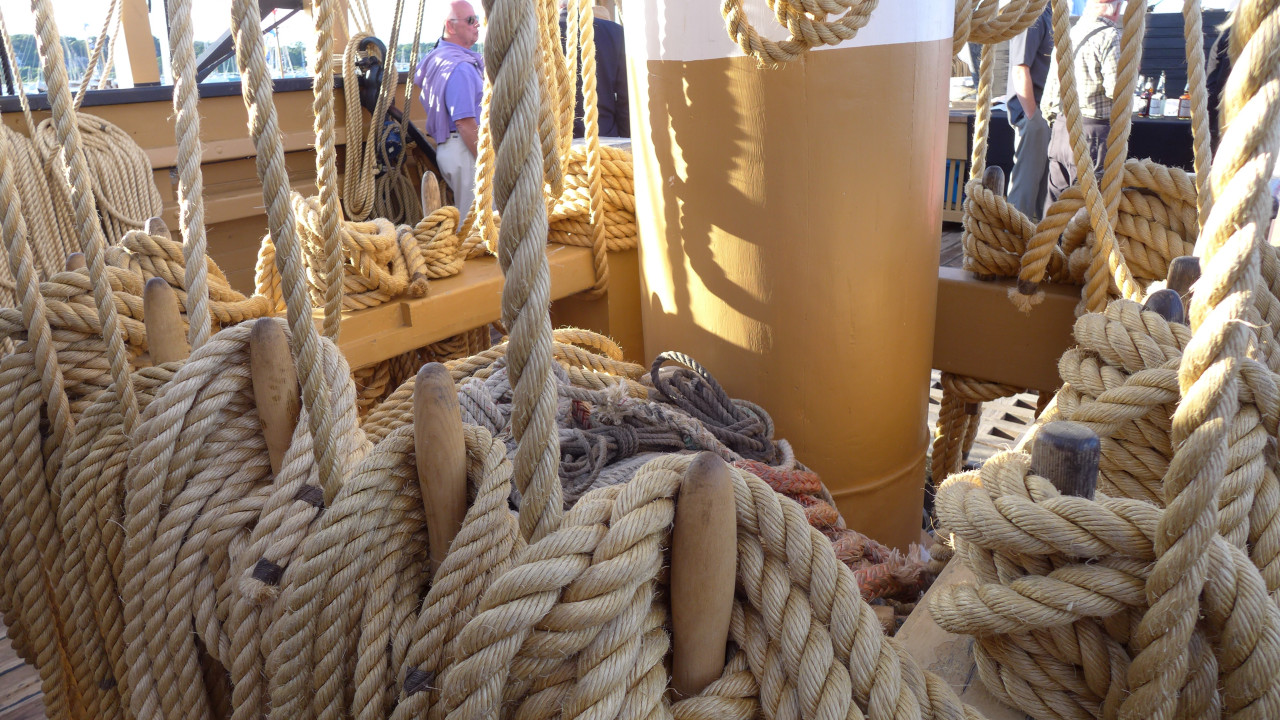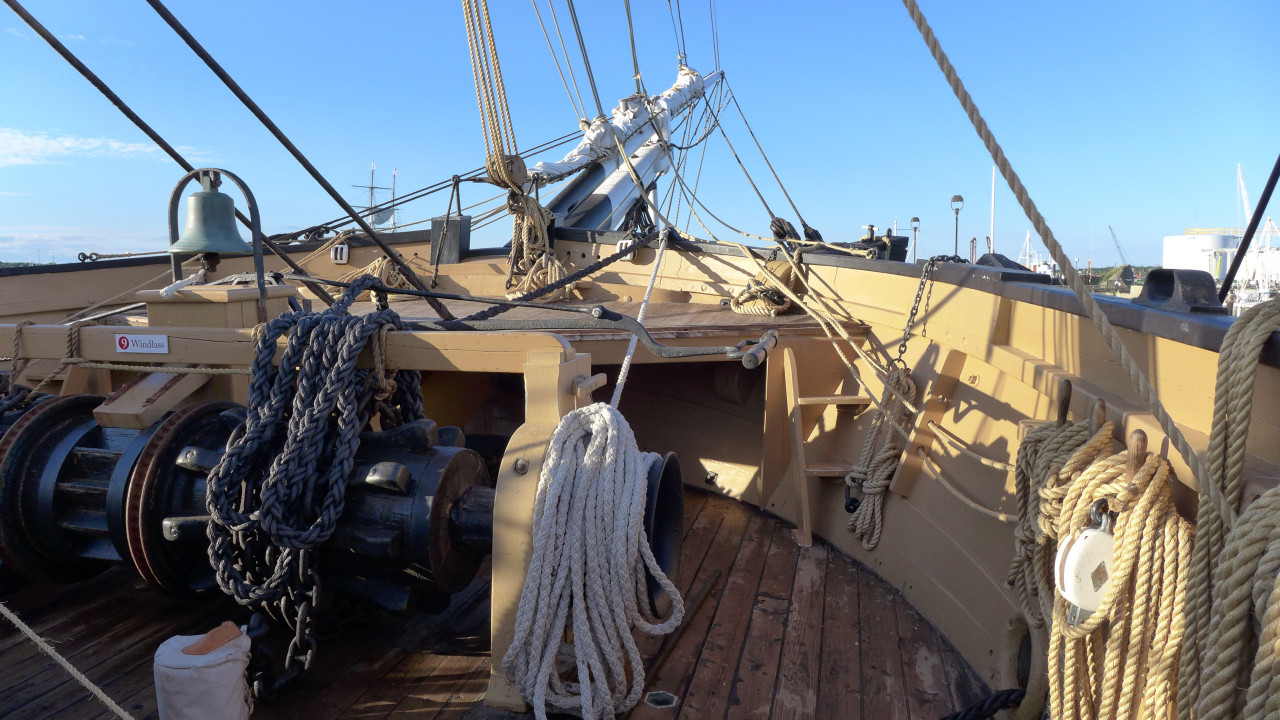Advertisement
World's Last Wooden Whaling Ship Has A Complicated History

Not long ago, we ventured out to Martha's Vineyard to visit a legendary lady — the Charles W. Morgan. She's a wooden whaling ship — one of the last of her kind on earth.

Kip Files is captain of the ship. He looks like an old hand who's realizing a boyhood dream. He unfurled his first sail at 5 years old and now he's the 22nd captain of the Morgan.
America's whaling fleet once numbered more than 2,700 vessels. The Morgan was built and launched from New Bedford in 1841, at the height of that whaling era. She sailed on 37 voyages to just about every corner of the earth, in search of whales. They're now, of course, a protected and beloved animal. But Files says that very fact makes the Morgan's complicated history that much more important.
Standing aboard this ship gives us a glimpse at the brutal, bloody effort that went into America's rise as a commercial power in the 19th century, he says.
"Think of the opportunity it is to sail a vessel like this. Someone who fought in the War of 1812 could have helped build it. Someone that was in the Civil War could have sailed it. The historical connection to this country is unparalleled with anything afloat right now, in the commercial aspect. We have the wonderful U.S.S. constitution, but that's a military vessel. This is a commercial vessel. This vessel represents growth and wealth. This vessel paid taxes so you could build a vessel like the Constitution."
Like the U.S.S. Constitution at the Charlestown Navy Yard, the Morgan is also a national historic landmark. She's undergone a lengthy and extensive refurbishment that's allowed her to sail from Mystic Seaport in Connecticut to Newport and Martha's Vineyard, then onto New Bedford. The Morgan will eventually make it's way to Boston in July.
The ship contains thousands of feet of line, thick as baseball bats, both soaring overhead and in holding down gear an elegant complicated knots.
Advertisement

We spent much of the day with Matthew Stackpole, official ship's historian for the Charles W. Morgan.
"All these lines have a purpose," says Matthew Stackpole, the ship's official historian. "You know that old expression, learning the ropes? That's what the sailors had to do. They had to learn all these ropes. They had to know what they did and they had to be able to find them in the night, so learning the ropes was not an abstract thing. You really had to do it. But that's one of the great things about the ship being set up like this. People can see all of the gear that was necessary to drive these ships."
Stackpole says America's 19th century whaling fleet was driven long and driven hard, with more than 14,000 voyages under sail.
"Charles W. Morgan was the principle owner, that means investor, in the ship," says Stackpole. "He owned 50 percent of it. But as an example of how the capital from whaling had an impact on the whole economy, he was also invested in textile mills. He owned a candle-making factory, he was invested in iron foundries. He was invested in railroads. All the growth of the country, at that point in the 19th century, those aspects of it were partially fueled by the money that came out of whaling."
The oil that was coming from the whales is basically like the oil that we're getting out of the ground today.
"The quest for energy, that's one of the things we think about this ship," says Stackpole. "It's relevant today because there are issues we're still wrestling with as to, 'How do we respond to the search and need for energy?'"
Guest
Kip Files, captain of the Charles W. Morgan, which tweets @38thVoyage.
Matthew Stackpole, historian for the Charles W. Morgan.
Highlights
On the Charles W. Morgan's typical voyage:
Matthew Stackpole: "Voyages at that time, from New Bedford, and before that from Nantucket, were typically around Cape Horn to the Pacific. They first started in the Atlantic and then, in the late 1700s, whale ships started to get around to the Pacific. They were pursuing the Sperm Whale. The Charles W. Morgan's first voyage lasted three years, three months and 27 days. She went across the Atlantic, down around Cape Horn, up along the equator, finally made her way up to the Gulf of Alaska, back along the coast of North and South America, around Cape Horn and back home."
On the technology of the ship:
MS: "This was the product of 150 years of experience. Everything had been refined. When we think of high-tech today, this doesn't look high-tech. But when she was built she represented all the knowledge of those 150 years before her, so she was functionally driven. Her design was formed by function and she was designed to be able to do this. She was designed to be able to sail. She was designed to be a place where people could live and she was designed to be able to carry 90,000 gallons of oil."

On what happened when the crew members spotted a whale:
MS: "The lookout would spot a whale and yell to the deck, 'Thar she blows!' Or, 'Thar blows!' They would lower one of the whale boats — this ship carried five whale boats — with a crew of six. Then they would harpoon the whale. This is something that a lot of people don't know — they harpooned the whale but that didn't kill the whale. That just attached the whale boat to the whale. The first thing that might happen is the famous Nantucket sleigh ride, where the whale would race away because it's been stuck with this sharp thing and they would sometimes be pulled for miles, sometimes over the horizon, or sometimes the whale would sound or dive and they had to have about 3,000 feet of line with them in the whale boat to let it out and get it back in."
On the killing of the whale:
MS: "The final killing of the whale was not abstract, it was very intimate in the sense that the whale boat had to get very close to it. They took another implement called a lance, which is a real sharp one with a long skinny blade, and that was designed so that they would try to puncture a lung or a major artery. That's how they killed the whale. Now we have a dead whale. If the ship is a long way away, they start towing it back. It weighs a ton a foot. They tie the whale alongside with the tail forward and right over here was the cutting in area. They would hook a big hook into it and they would take the blubber off the whale, similar to the way that we would peel an orange today. It literally would peel off. And they would take pieces that weighed about 1,000 to 2,000 pounds out, they were called blanket pieces, lower them into this hold behind me where they would cut into smaller pieces, then work back up on deck where they would cut up even more and put in these iron tripods on the ship where they were essentially rendered or melted and that's how they got the oil out of it."
On the importance of whaling history:
MS: "Obviously, today, we have a whole different view of whales and what they are and what we should do to protect and preserve them. The reason for something like this to be remembered is not to romanticize or to celebrate or to demean what it did. It's to remember it. The reason for history is to improve today and tomorrow so some of the things that this ship did accomplish — exploration and discovery, technological development, entrepreneurship, the spirit of American enterprise, that's all pretty amazing. The fact that there was a finite number of whales in the 19th century wasn't even in their imagination, so what do we need to think about in terms of our potential impact on the world around us, whether it's the oceans or the air. What about energy? How do we solve our quest for energy? When whaling ended, the quest for energy didn't. There were just other alternatives. So, what we like to say is the ship's cargo today is history. It's not oil anymore. And it's to bring attention to some of these things that are worth thinking about and considering."
More
The Boston Globe: New Bedford Looks To Future As Storied Whaler Returns
- "And when the whaleship Charles W. Morgan returned Wednesday to the harbor where it was launched 173 years ago, it carried the hopes of city leaders who want it to draw attention to New Bedford’s revival as a vibrant port. They want to showcase their vision of the city as a leader in that most 21st-century of energy sources, offshore wind, and shed the image of a decrepit former mill town with high crime and unemployment rates."
This article was originally published on June 27, 2014.
This segment aired on June 27, 2014.